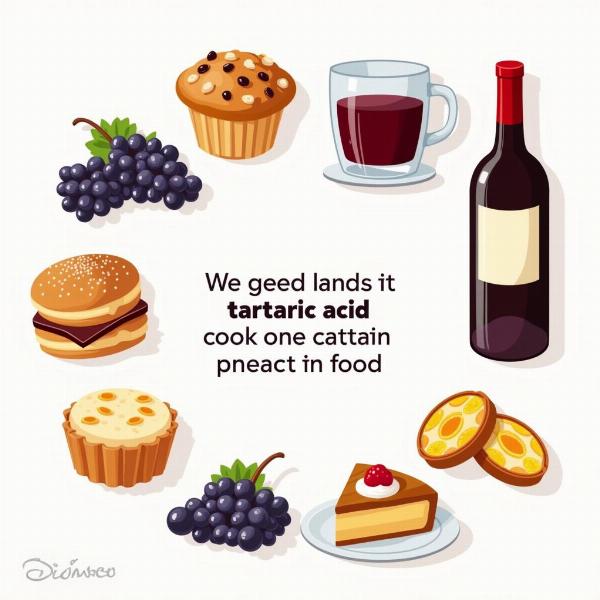Tartaric acid, a common organic acid found in many fruits, particularly grapes, plays a significant role in winemaking and various culinary applications. Understanding its meaning in Hindi can be beneficial for anyone interested in food science, chemistry, or simply expanding their vocabulary. This article delves into the meaning, uses, and importance of tartaric acid, providing a clear and comprehensive understanding of this important compound.
What Does Tartaric Mean in Hindi?
The Hindi word for tartaric acid is “टार्टरिक अम्ल” (tartarik aml). This term is a direct translation, combining “टार्टरिक” (tartarik), derived from the English word “tartaric,” and “अम्ल” (aml), the Hindi word for “acid.” This straightforward translation makes it easy to understand and remember for Hindi speakers.
Uses of Tartaric Acid
Tartaric acid is a versatile compound with a wide range of applications. Its primary use is in the winemaking industry, where it contributes to the overall taste, color, and stability of wine. Beyond winemaking, tartaric acid is commonly used as a leavening agent in baking, providing a tangy flavor and contributing to the texture of baked goods. It’s also an ingredient in various food products like candies, jams, and jellies, acting as an antioxidant and acidity regulator.
Tartaric Acid in Everyday Life: Why It Matters
Though often unnoticed, tartaric acid plays a subtle yet significant role in our daily lives. From the food we consume to the medications we take, its presence enhances flavor, stability, and effectiveness. Understanding its properties and applications can provide valuable insights into the chemistry of everyday life.
How is Tartaric Acid Extracted?
Tartaric acid is primarily extracted from the byproduct of winemaking, known as potassium bitartrate or cream of tartar. This extraction process involves several chemical reactions, ultimately yielding pure tartaric acid crystals.
What are the Health Benefits of Tartaric Acid?
While not a miracle cure, tartaric acid possesses some potential health benefits. It’s an antioxidant, which means it can help protect the body against damage from free radicals. Some studies suggest it may also improve digestion and gut health.
 Tartaric Acid in Food
Tartaric Acid in Food
Conclusion
Tartaric acid, known as “टार्टरिक अम्ल” (tartarik aml) in Hindi, is a crucial component in numerous applications, from winemaking to food production. Understanding its meaning and uses provides valuable insight into the chemistry of everyday products. This comprehensive guide has explored its various facets, enriching our understanding of this essential compound.
FAQ
- What is the chemical formula of tartaric acid? C₄H₆O₆
- Is tartaric acid harmful? Generally, tartaric acid is safe for consumption in moderate amounts.
- What is the role of tartaric acid in baking? It acts as a leavening agent, providing a tangy flavor.
- Can tartaric acid be found naturally? Yes, it’s naturally present in many fruits, especially grapes.
- What is cream of tartar? It’s a byproduct of winemaking and a source of tartaric acid.
- Where can I buy tartaric acid? It’s available in many grocery stores and online retailers.
- What are some other names for tartaric acid? It’s sometimes referred to as dihydroxybutanedioic acid or 2,3-dihydroxybutanedioic acid.
Meaning-Hindi.in is your trusted partner for accurate and culturally sensitive Hindi translation services. We specialize in various translation domains, including business and commercial documents, legal and certified translations, technical manuals, website localization, educational and academic materials, and expedited translation services. Our expertise in specialized fields ensures high-quality and precise translations tailored to your specific needs. Contact us today for all your Hindi translation requirements! Email: [email protected], Phone: +91 11-4502-7584. Let Meaning-Hindi.in bridge the language gap for you.